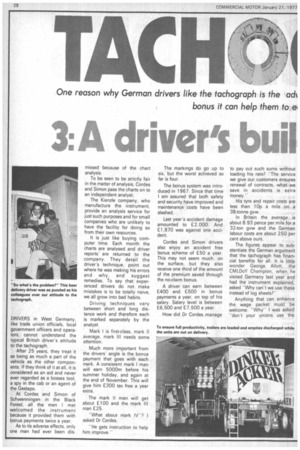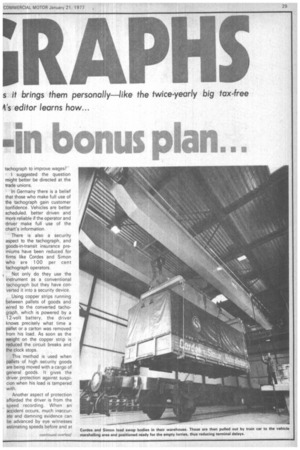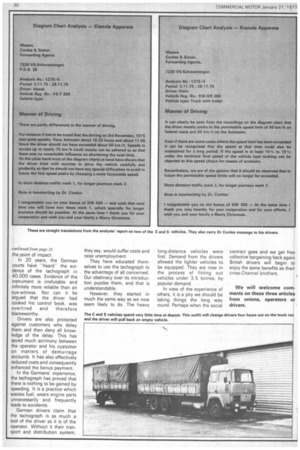3:A driver's bull
Page 30

Page 31

Page 32

If you've noticed an error in this article please click here to report it so we can fix it.
min bonus plan..
DRIVERS in West Germany, like trade union officials, local government officers and operators, cannot understand the typical British driver's attitude to the tachograph.
After 25 years, they treat it as being as much a part of the vehicle as the other components. If they think of it at all, it is considered as an aid and never ever regarded as a bosses tool, a spy in the cab or an agent of the Gestapo.
At Cordes and Simon of Schwenningen in the Black Forest, all the men I met welcomed the instrument because it provided them with bonus payments twice a year.
As to its adverse effects, only one man had ever been dis missed because of the chart analysis.
To be seen to be strictly fair in the matter of analysis, Cordes and Simon pass the charts on to an independent analyst.
The Kienzle company, who manufacture the instrument, provide an analysis service for just such purposes and for small companies who are unlikely to have the facility for doing so from their own resources.
It is just like buying computer time. Each month the charts are analysed and driver reports are returned to the company. They detail the driver's technique, point out where he was making his errors and why, and suggest remedies. To say that experienced drivers do not make mistakes is to be totally naive, we all grow into bad habits.
Driving techniques vary between short and long distance work and therefore each is marked separately by the analyst.
Mark I is first-class, mark II average, mark III needs some attention.
Much more important from the drivers' angle is the bonus payment that goes with each mark. A consistent mark I man will earn 500Dm before his summer holiday, and again at the end of November. This will give him £300 tax free a year extra.
The mark II man will get about £100 and the mark III man £25.
-What about mark IV"? I asked Dr Cordes.
"He gets instruction to help him improve.
The markings do go up to six, but the worst achieved so far is four.
The bonus system was introduced in 1967. Since that time I am assured that both safety and security have improved and maintenance costs have been slashed.
Last year's accident damage amounted to £2,000. And £1,870 was against one accident.
Cordes and Simon drivers also enjoy an accident free bonus scheme of £50 a year. This may not seem much, on the surface, but they also receive one third of the amount of the premium saved through the no-claim bonus.
A driver can earn between £400 and £500 in bonus payments a year, on top of his salary. Salary level is between £6,500 and £7,500 a year.
How did Dr Cordes manage to pay out such sums without loading his rate? "The service we give our customers ensures renewal of contracts, what we save in accidents is extra money."
His tyre and repair costs are less than 10p a mile on a 38-tonne gvw.
In Britain the average is about 8.93 pence per mile for a 32-ton gvw and the German labour costs are about 250 per cent above ours.
The figures appear to substantiate the German argument that the tachograph has financial benefits for all. It is little wonder George Allott, the CMLDoY Champion, when he visited Germany last year and had the instrument explained, asked "Why can't we use these instead of log sheets?"
Anything that can enhance the wage packet must be welcome. "WhyI was asked -don't your unions use the
tachograph to improve wages?" I suggested the question might better be directed at the trade unions.
In Germany there is a belief that those who make full use of the tachograph gain customer confidence. Vehicles are better scheduled, better driven and more reliable if the operator and driver make full use of the chart's information.
There is also a security aspect to the tachograph, and goods-in-transit insurance premiums have been reduced for firms like Cordes and Simon who are 100 per cent tachograph operators.
Not only do they use the instrument as a conventional tachograph but they have converted it into a security device.
Using copper strips running between pallets of goods and wired to the converted tachograph, which is powered by a 1 2-volt battery, the driver knows precisely what time a pallet or a carton was removed from his load. As soon as the weight on the copper strip is reduced the circuit breaks and the clock stops.
This method is used when pallets of high security goods are being moved with a cargo of general goods. It gives the driver protection against suspicion when his load is tampered with.
Another aspect of protection afforded the driver is from the , speed recording. When an accident occurs, much inaccurate and damning evidence can be advanced by eye witnesses estimating speeds before and at
In 20 years, the German courts have -heard" the evidence of the tachograph in 40,000 cases. Evidence of the instrument is irrefutable and infinitely more reliable than an eye-witness. Nor can it be argued that the driver had cooked his control book, was
overtired and therefore blameworthy.
Drivers are also protected against customers who delay them and then deny all knowledge of the delay. This has saved much acrimony between the operator and his customer on matters of demurrage accounts. It has also effectively reduced costs and consequently enhanced the bonus payment.
In the Germans' experience, the tachograph has proved that there is nothing to be gained by speeding. It is a practice which wastes fuel, wears engine parts unnecessarily and frequently leads to accidents.
German drivers claim that the tachograph is as much a tool of the driver as it is of the operator. Without it their transport and distribution system, they say, would suffer costs and raise unemployment.
They have educated themselves to use the tachograph to the advantage of all concerned. Our obstinacy over its introduction puzzles them, and that is understandable However, they started in much the same way as we now seem likely to do. The heavy long-distance vehicles were first. Demand from the drivers allowed the lighter vehicles to be equipped. They are now in the process of fitting out vehicles under 3.5 tonnes, by popular demand.
In view of the experience of others, it is a pity we should be taking things the long way round Perhaps when the social contract goes and we get free collective bargaining back again British drivers will begin to enjoy the same benefits as their cross-Channel brothers.


























































































































